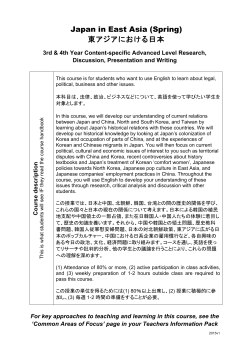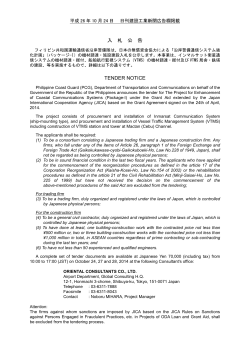
Kyoto Crafts meets HOSHINOYA Design The
Press Release 10/05/26 Kyoto Crafts meets HOSHINOYA Design The Creators of the HOSHINOYA Kyoto Through long centuries, the crafts persons of Kyoto have refined their skills to the level of the sublime. The quality that is uniquely ‘HOSHINOYA Kyoto’ comes from design that fuses this craft with the comforts demanded by modern times. From a redefinition of traditional Japanese room style to architecture, landscaping and decoration, this philosophy is manifested throughout. The result is an authentic Japanese experience presented with all the comforts of the present day. Rie AZUMA×HOSHINOYA Hiroki HASEGAWA×HOSHINOYA Architectual Design Landscape Design Breathing new life into traditional architecture In Kyoto’s Arashiyama district, we were given the challenge of how to breathe new life into a traditional building with many years of history behind it. Our task was not to simply restore an old building; we wanted to propose a new approach, ‘Authentic Japan’, following in the steps of HOSHINOYA Karuizawa. In Kyoto are preserved the techniques of craftsmen with whom modern life rarely brings us into contact: the crafts of Kyoto-style woodblock-printed paper, lattices, plastering, roof tile, and a specialized knowledge of hard-to-find types of wood. It is a place that, enviably, preserves traditional crafts in its daily life. It is also an area that I believe, along with its antiquity, has an element of the avant-garde as well. We have conceived of this project, with the lightness inherent in Japanese wood architecture and the arrangement of guest rooms into individual units, as giving rise to a sense of being created by history. And at the same time offering a ‘HOSHINOYA’ lifestyle and relaxing comfort, and we invite you to enjoy this space offered you by the history of Kyoto and the new life breathed into it by our creative team. Japan is one of the few countries, especially today, in which gardens form a major part of traditional culture, and it is because of the weight of that tradition that I felt it would be possible to try something new in the way of landscape design. I felt it has always been characteristic of Japan that within the classic culture we have received, there has always been both a movement to further refine it operating in collision with one wishing to break it down and create new forms. While we are outsiders in Kyoto, we have taken inspiration from this thousand year-old city and, presumptuous as it may sound, we feel the result is a creative addition to its culture. In real terms, we have with HOSHINOYA Kyoto given form to this feeling of experimentation by designing the gardenttes with the collaboration of both metal crafts-persons in Tokyo and Kyoto gardeners, and while the paving stones at the entrance may look classical, we have chosen for them materials that are not often utilized this way. President Azuma Architect & Associates President Studio on site LTD. co Atelier Maruni ×HOSHINOYA Kyoto Style Woodblock Printed Paper Takeo Honjo is one of very few craftsmen working with the Kyoto-style woodblockprinted paper used on sliding doors, and he has created paper for such important buildings as the Detached Palace and the Nijo Castle. He is the only craftsman now carrying on the techniques of Kyoto-style ‘crinkled paper’. Blending such pigments as crushed white oyster-shell powder, red iron oxide, ultramarine, yellow ochre, India ink, and mica on a 130 year-old woodblock, he gently presses Japanese washi paper onto it. Each 3-by-6 foot sheet of paper is pressed with 12 separate color arrangements, twice for each, giving a total of 24 impressions for each completed sheet. This paper, which at a glance looks quite simple, is printed to an amazing degree of exquisiteness, and is used on the bed boards and sliding doors of our guest rooms. Enjoy the profound changes in effect that lamplight brings to these traditional patterns refined over long years, their traditional Japanese esthetic engendering variations and textures only possible when created by hand. Hinoki Kogei ×HOSHINOYA Furnitures The artisans of Hinoki Kogei are Japan’s foremost makers of furniture. The contents of a traditional Japanese room are made to appear at their most beautiful at the eye level of a viewer kneeling formally. Chuzo Tozawa and his son Tadakatsu, respectively Chairman and President, have kept the Japanese esthetic of interior design firmly in mind in providing a comfortable piece of furniture on which to relax, their ‘tatami sofa’. These utilize lignitized Japanese cedar and pine, buried for many years in the earth to give it distinctive characteristics, while the backrests, reminiscent in design of the famous Sagano bamboo grove nearby, feature supports which function individually to gently support the body by adapting to the curve of the back. This ‘rediscovery of the Japanese room’ also manifests itself in the tea chests, beds, tables, and other furniture in the lounge and elsewhere. by hand. Nishaya ×HOSHINOYA Arai, Polishment The trade of painter is an important one for the many historic buildings that remain in Kyoto. These are the people who flawlessly bring back to life for future generations important old buildings made with ancient skills and materials that cannot be reproduced today. The application of a ‘Arai, Polishment’ is very important to our century-old ‘tea-house’-style building. Things like eaves, cabinets, or the frames of sliding doors are steam-cleaned, and preservative carefully brushed on and wiped away on a regular basis. This seems like a rather thankless job, but those sections that appear to be fading away with age are thus restored to their original luster, and beautifully brought back to life. The work of Nishaya and his crew in conveying the past safely into the future is evident all through HOSHINOYA Kyoto. Miura Shomei ×HOSHINOYA Lighting It is in lighting that we have realized in the most concrete terms our HOSHINOYA project of bringing new life to old traditions by having the artisans of Kyoto create on the basis of our designs. It is important in the traditional Japanese esthetic that things like Kyoto-style woodblock-printed paper or lacquer-ware take on their greatest luster in subtle lamplight. Lighting in a Japanese room plays a vital supporting role in delivering an amazing feeling of warmth and security, along with the pleasure of a shadowy world lost in the bright fluorescent illumination amid which we live today. The long-established Miura Shomei Co. provides lighting that conjures up the traditional beauty of the Japanese room. The craftsman Einosuke Tazuke has for many years had a keen eye for the use of a soldering iron and the bend in sheet metal in the making of brass-frame lamps. These lighting fixtures are created by superb artisans and placed so as to subtly illuminate the rooms of the HOSHINOYA with settled warmth. Ueya Kato Zoen×HOSHINOYA Gardener HOSHINOYA Kyoto features two Japanese gardens: the waterfall-and-pond ‘Water Garden’ and the ‘Hidden Garden’, incorporating oxidized tile. Following in the footsteps of Japanese gardening traditions, they have been designed to inspire the HOSHINOYA sense of modernity in coexistence with the grandeur of their setting in the Arashiyama gorge. Their actual creation is due to the long-nurtured expertise of Ueya Kato Zoen, established in 1848 and the builder of gardens for many cultural foundations. Implicit everywhere in these gardens is the playful spirit of their landscapers, whose long experience in Japanese tradition and esthetics incorporates a new point of view shared with HOSHINOYA. Exit Metal Work Supply × HOSHINOYA Metalwork Covering the ground in the Tsuki Maisonette private garden is an iron plate designed in a chrysanthemum pattern; this is a new style of gardenette using metalwork to carry on the esthetic and spirit of earlier times that found beauty in evidence of the temporal nature of all around us. It is the work of Exit Metal Work Supply, whose craftsmen create furniture and utensils of metal. Kaoru Shimizu, its president, worked with the design firm IDEE Co., Ltd. before starting his own company. The chrysanthemum pattern was created on melted iron with welding equipment; the iron was then allowed to oxidize naturally to an esthetically pleasing degree, at which point rust preventer was applied. Viewed from the ground floor, it is a traditional Japanese gardenette, complete with ‘tea-house’ style tsukubai, water basin. With the bird’s-eye view from the 2nd floor, however, the overall pattern takes shape. Experience this new approach to the Japanese garden.
© Copyright 2025












